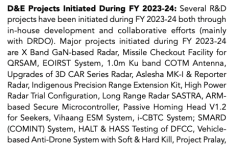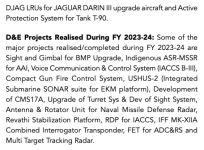You are using an out of date browser. It may not display this or other websites correctly.
You should upgrade or use an alternative browser.
You should upgrade or use an alternative browser.
This is a good development. Premier explosives were the sole maker of chaffs & flares so far. Now the other co is also about to join the fray.
In a visit to review Make-in-India projects to Nagpur, Deputy Chief of Air Staff Air Marshal Ashutosh Dixit inaugurated the Chaff Manufacturing Plant at Economic Explosives Limited (EEL), Nagpur on July 31. EEL is a 100% subsidiary of Solar Industries India Limited. Chaff is one of the most widely used and effective expendable electronic countermeasure device. It is dispensed into the atmosphere to deny radar acquisition, generate false targets and to deny or disrupt tracking by enemy radar.
Solar has set up the first fully indigenous state-of-the-art production plant at Nagpur. Until now, the country had been fully dependent on imports. The Chaff payloads were developed by EEL with Technology Support from DRDO’s Defence Laboratory, Jodhpur under the category of Buy Indian-IDDM (Indigenously Designed, Developed and Manufactured). EEL has got airworthiness certificate from Airforce Inspecting Authorities for the Chaff payloads manufactured inhouse, thus paving the way for fitment on aircraft, helicopter and other airborne platforms.Keeping in view the huge requirement of Chaffs by Armed Forces, EEL is augmenting its manufacturing capacity which will be completed in another six months time. In India this is first modern and advanced technology plant to produce the Chaff fibres with enhanced quality features: Solar Industries
Can you name those companies ?If everything goes ahead, private company capacity itself would be at least 3 lakh shells per year from 2 companies, could be 4 lakh if Adani also starts making. This is minus the psu production capacity, given the surplus they are trying to actively export as of now.
Well Goodluck Defence and Adani so far I know, besides Kalyani. Few more might be on it soon lets see.Can you name those companies ?
Another one:Well Goodluck Defence and Adani so far I know, besides Kalyani. Few more might be on it soon lets see.
Anshuni Limited receives Rs 682 crore letter of interest for supply of 155mm shells
155mm M107 Empty Shells, subcontract basically.
Yeah the psu orders are mostly empty shells subcontracts. We have to see what the others make, hopefully fully furnished shells.155mm M107 Empty Shells, subcontract basically.
There was one doc which you shared that mentioned DRDO is developing a Naval Air Search Radar. Can you share that doc if possible?
I forgot which are you referring to.There was one doc which you shared that mentioned DRDO is developing a Naval Air Search Radar. Can you share that doc if possible?
There was one doc mentioning that Navy is using Lanza ASR but for future we are developing our own ASR.I forgot which are you referring to.
Impossible to remember exactly where tbh.There was one doc mentioning that Navy is using Lanza ASR but for future we are developing our own ASR.
This pic will alone give nightmare to corrupt generals.
They doubt they are hellbent on derailing them.
They doubt they are hellbent on derailing them.










